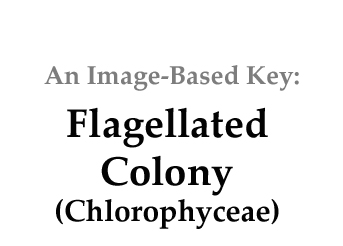|
Home / Chlorophyceae / Colonies / Flagellated |
|
|
||||
|
|
||||
|
|
||||
|
|
||||
|
|
||||
|
|
||||
|
Flagellated colonies in the 'volvocine line' are
considered to have arisen from the unicell predecessor Chlamydomonas and ending with Volvox
spp. with its communication network of plasmodesmata interconnecting all
cells. The proportion of reproductive
cells decreases along the way, with Volvox
having the fewest ‘gonidia’ out of >1,000 (up to 50,000) somatic
flagellated cells. Most colonies are hollow spheres with a single
layer of flagellated cells on the periphery.
Exceptions are Platydorina
and Gonium
with flattened 2D colonies one cell thick, and Pyrobotrys and
Spondylomorum with a 3D cluster of cells lacking a hollow center of the
colony. Movement of the spherical flagellated colonies
is always clockwise as the colonies move forward in a right-handed helical
pattern resulting from the right-hand orientation of all flagella. Phototaxis is achieved by changing the rate
of beat of the flagella, not by a change in their spatial orientation
(Gerisch 1959). |
||||
|
REFERENCES |
||||
|
Gerisch, G. 1959. Die Zelldifferenzierung bei Pleodorina californica Shaw and die Organisation der Phytomonadinenkolonien. Archiv fur Protistenkunde 104:292-358. online |
||||
|
|
||||
|
Home / Chlorophyceae
/ Colonies / Flagellated |
||||







.jpg)



